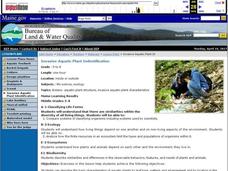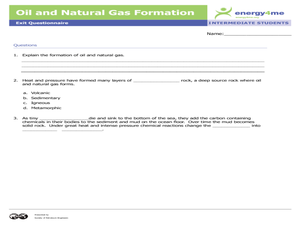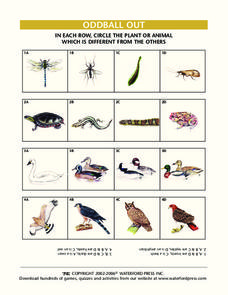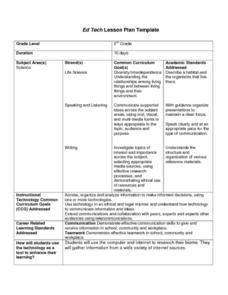Curated OER
Be Kind to Mother Nature!
A clever worksheet on identifying things that harm the environment is here for you. Elementary schoolers read a short paragraph describing the harm that can come to the environment due to human activities. Then, they must circle five...
Curated OER
Build a Coral Polyp
Students build a coral polyp out of a banana, straw, oyster crackers, sprinkles, and more. In this coral polyp lesson plan, students also list the differences between plants and animals.
Curated OER
Coral Polyp Party
Students complete a project where they label the parts of a coral polyp and discuss the differences between plants and animals. Students use marshmallows, sprinkles, toothpicks, and more to label their coral polyp.
Curated OER
Animal Classification
Students are introduced to the concept of classification as it relates to objects, information, and characteristics. For this classification lesson, students research a variety of animals. Students study the Linnaeus's system of...
Curated OER
Animals and Plants of BC's Rocky Shore
Students fill out a fact sheet and look at diagrams of BC's shore and the animals that live there. In this habitat lesson plan, students discuss the plants and animals and the different zones they live in.
Curated OER
Plants and Animals
Students find common needs between plants and animals. In this plants and animals lesson students compare that both plants and animals need food and water. They also find the differences between plant and animal needs.
Curated OER
The Living Environment
Students use a spoon, clothespin, scissors, and toothpicks to simulate how animals get food in their environment. In this environment lesson plan, students learn about the adaptations animals make in order to survive.
Curated OER
The Web of Life
Students construct a food web to learn how living things in an ecosystem are interconnected. In this food web simulation instructional activity, students will be assigned an animal and the teacher will represent the sun. Students and...
Curated OER
Food Chains and Food Webs
In this biology worksheet, students read about food chains and food webs. They then answer 4 questions regarding the information they just learned. The answers are on the last page in the packet.
Curated OER
Invasive Aquatic Plant Identification
Young scholars observe aquatic plants and animals and identify their systems. In this plants and animals lesson plan, students compare systems of organisms and orally express how plants and animals rely on each other.
Curated OER
Oil and Natural Gas Formation
Students complete a narrative paper and a drawing depicting how the formation of oil and natural gas taken from the Earth's crust were once plants and animals millions of years ago. In this oil and natural gas lesson plan, students read,...
Curated OER
The Living Environment
Fourth graders make a chart of animals and plants that live in either the desert, the ocean, or the tundra. For this environment lesson plan, 4th graders work in groups to discover characteristics needed for these animals to live in that...
Curated OER
Transportation
Students read about various modes of transportation for people, plants, and animals. In this transportation lesson plan, students read information about the transportation modes for people plants, and animals using water and land....
Curated OER
Science - What Can Living Things Do
In these living things worksheets, students write true or false for the sentences about living things. Students answer the questions about living things and choose the words that best describe the statements about living things.
Curated OER
Investigating Food Chain
In this food chain activity, students look at an example of a food chain and draw 4 animals for each food chain. There are 4 different food chains.
Curated OER
Our Australia: The Plants and Animals of Australia
In this Australia worksheet, students 19 questions regarding the plants and animals of Australia. A print out version of this worksheet is available, but the online version contains links to various webpages with information on the...
Curated OER
Plants and Animals Word Search
In this science activity, students examine labeled pictures of birds, plants and mammals. Students locate the names in a word search puzzle.
Curated OER
Where Are All the Plants? Where Are All the Animals?
In this categorizing worksheet, students examine 8 pictures. Students cut out and paste the plants in the box. Then on the next page, students choose the animal pictures and paste them in the box. There will be half of the pictures not...
Curated OER
Oddball Out: Plants and Animals
In this problem solving worksheet, students analyze a row of pictures of various plants and animals to determine which creature is different from the others pictured.
Curated OER
Oddball Out: Plants and Animals
In this problem solving worksheet, students analyze a row of pictures of various plants and animals to determine which creature is different from the others pictured.
Curated OER
Organisms and Habitats
Second graders investigate biomes and the plants and animals that are native to particular biomes. They participate in a class discussion, conduct Internet research on a selected biome, and create a shoebox biome using their Internet...
Curated OER
This Is Tree-rific!
Third graders view a clip of the video Backyard Safari, "Trees," and portray the life cycle of a tree. They also view a clip on structures of a tree and draw a diagram of a tree in their science journals.























